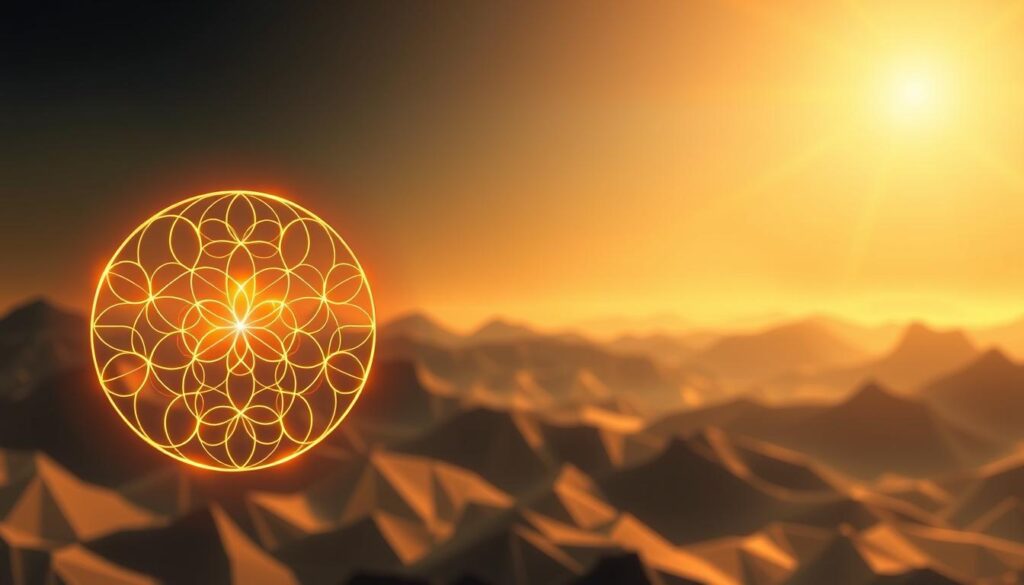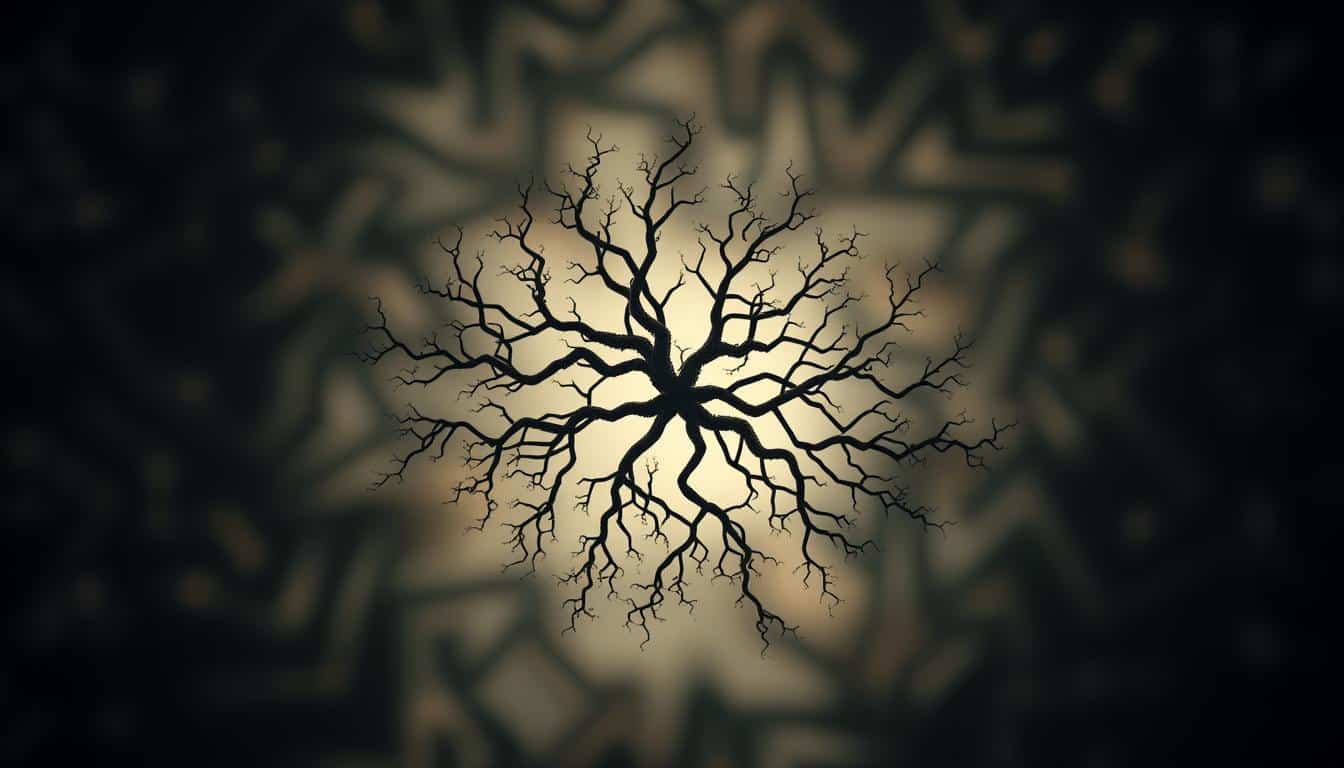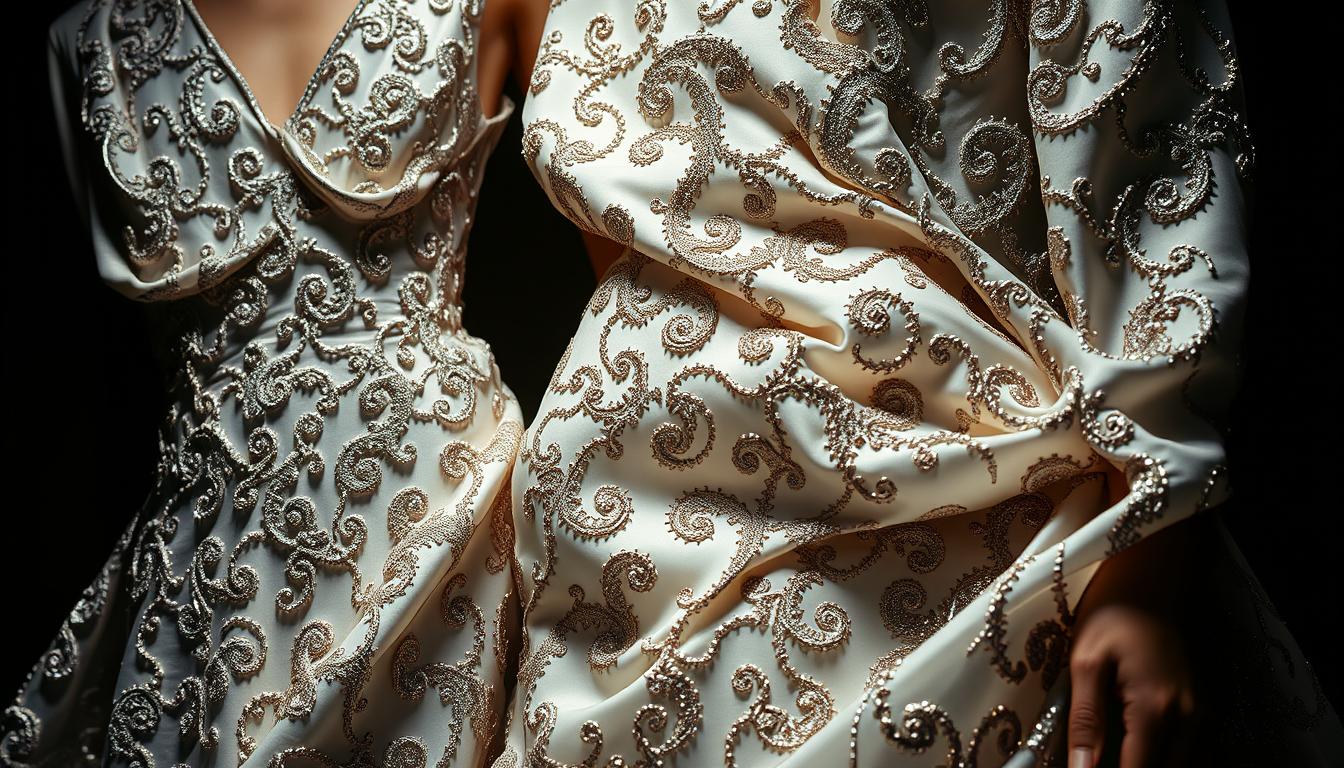Artistic expression takes a fascinating turn when fractal patterns meet sacred geometry. These forms captivate people everywhere. This article dives into how sacred geometry and religious art are closely linked. We show how geometric patterns are a universal language beyond culture.
We explore the blend of math and spirituality in art. This mix helps us see beauty and meaning in old and new ways.
Introduction to Sacred Geometry and Fractals
Sacred geometry captures our wonder, linking math shapes with their spiritual meaning. It shows how nature-inspired shapes show cosmic order and the universe’s structure. This base leads us to the fractals world, revealing complex patterns in art and science.
Fractals are visual examples of math. They appear in physics, biology, and art. Looking into these areas, people find a cultural rebirth. It’s about seeing how patterns fuel creativity and expression. This journey blurs the art-science divide, uniting them.

What is Sacred Geometry?
Sacred geometry is the idea that some shapes and proportions are spiritually meaningful. Ancient cultures believed these shapes linked humans to something greater. The pyramids and Greek temples show this belief. They thought these shapes connected them to higher existence levels.
Historical Significance in Ancient Civilizations
Ancient societies used sacred geometry as more than building plans. It was their way to find spiritual insight. Egypt and India, for example, designed their sacred places with these patterns in mind. They used shapes like:
- The Flower of Life
- Mandala designs
- Platonic solids
These shapes were full of spiritual meanings. They represented ideas of unity and the connection between our world and something beyond.
Symbolism and Spiritual Meaning
Sacred geometry is about more than just shapes. It’s about finding universal truths and something divine. The shapes urge us to look within ourselves. Things like the spiral of a shell show this sacred geometry in nature. These patterns show how everything is connected, inspiring us to explore our spiritual path.
The Significance of Fractals in Art
Fractals are where art meets math in a unique way. They show why fractals matter in art, more than just looking good. Artists use fractal patterns’ complexity to create engaging works on many levels.
Visual Appeal and Complexity
Fractals grab our attention with their artistic complexity. With each new look, they reveal more patterns, drawing viewers in. This depth keeps people looking and lets artists mix form and meaning in their work. Fractals turn simple ideas into deep, artistic experiences.
Connection Between Mathematics and Creativity
Fractals link math and creativity, sparking artistic innovation. Artists use them to bring mathematical ideas into visual stories. This mix enhances both art and math, creating a space where creativity blooms. Using fractals in art shows the beauty when math and creativity join.
Fractals: A Marriage of Mathematics and Art
Fractals bring together math and art in a fascinating way. These complex patterns connect the world of numbers with the realm of creativity. They let artists use math to create unique and beautiful art.
By using fractals, artists explore the ideas of symmetry, repetition, and scale. This opens up endless possibilities for artistic creation. It’s like having a new language of art.
Fractals have complex structures that look the same at different sizes. This shows the beauty of math in a way that catches the eye. Artists get inspired to explore new ideas, creating art that makes people see things differently. Together, math and art create something truly special.
Looking at fractals, art goes beyond just showing something. It’s about turning math into amazing visual experiences. This way of making art builds a bridge between math and creativity. As more artists use fractals, the connection between math and art gets stronger. This gives us new ways to see their relationship.
Sacred Geometry in Ancient Cultures
Sacred geometry shapes the buildings of many ancient civilizations. This art, based on mathematics, shows the spiritual beliefs of these communities. You can see its principles in global structures where design meets spirituality.
Influence on Architecture and Design
Many iconic buildings around the world show the impact of sacred geometry. Temples and mosques feature patterns that have deep spiritual meanings. For instance, Islamic architecture’s geometric patterns show a connection to the divine. Hindu temples use sacred geometry to represent gods and cosmic principles. These buildings’ alignment and size aim for universe harmony, showcasing sacred geometry’s values.
Spiritual Representations in Different Traditions
In various traditions, sacred geometry expresses spiritual ideas. Cultures blend geometry in their rituals and artifacts, seeking transcendence and a divine connection. Ancient Egyptians used geometric forms in burials and temples to help the soul’s journey. Native Americans used it to show their bond with nature and the universe. These uses show sacred geometry’s global spiritual themes and its cultural impact.
Understanding Fractal Art
Fractal art is the blend of math and creativity, creating stunning visuals. It uses complex algorithms to make amazing designs. These designs often mirror patterns in nature, showing the beauty in math.
Artists turn math formulas into colorful artwork. They use techniques like iteration and color changes. This enhances their art’s complexity and shows how numbers and beauty connect.
When people see fractal art, they discover the beauty in math. It makes them wonder about the links between art, nature, and numbers.
Techniques for Creating Sacred Geometry Fractal Art
Sacred geometry blends old art methods with new tech for an amazing view. Artists use different ways to make beautiful fractal designs. They show sacred geometry’s beauty through these patterns using computers.
Use of Computational Algorithms
Computational algorithms are key in making sacred geometry fractal art. Artists change math equations into complex pictures with these. They use steps and repeats in math to make precise fractals. With special software, they try out ideas and make unique art.
Exploration of Visual Symmetries
Looking at visual symmetries is vital in making intriguing fractal art. These symmetries make the art more appealing and show harmony and balance. Artists use repeating shapes and mirrors to connect viewers to the art. Through symmetry, they find new creative paths and lift sacred geometry art to new levels.
Exploring the Beauty of Fractal Art
Fractal art wows us with its complex and beautiful designs. It goes beyond normal art, drawing us into patterns seen in art and the natural world. These designs range from complicated visuals that spark curiosity to calming patterns that bring peace. Fractal art connects human creativity with the natural beauty around us.
Awe and Wonder in Artistic Expression
Fractal art is deeply complex and truly fascinating. It shows us unique patterns found in nature, like the way leaves are arranged or how coastlines look. This art makes us see the natural world in new ways, making us appreciate the little details of life even more.
Connection to Nature’s Patterns
Fractal art shows how everything in nature is connected. It mirrors the amazing designs found in trees, clouds, and faraway galaxies. By looking at these artworks, artists make us feel at peace and invite us to think about how we fit into the world. This makes us see the beauty in fractal art and the environment around us in a new light.
Mathematical Principles Behind Fractals
Fractals are built on key math principles. They’re key to understanding their complex patterns. Fractal geometry centers on self-similarity. This means patterns repeat at different sizes. This trait makes fractals complex but based on simple math rules.
Fractals are made with:
- Iterative equations: These formulas are used over and over to create new points or shapes. They help make the fractal shapes we see.
- Recursive algorithms: These are functions that repeat themselves. They make patterns that look alike, giving the fractal its depth.
- Fractal dimensions: These aren’t like normal dimensions. They show how fractals get more complex with size.
These math principles show the beauty of fractal geometry. They link art with nature. Fractals show how math and creativity meet. They blend order and chaos in amazing ways.
The Intersection of Art and Science in Fractal Geometry
Fractal geometry is where art and science meet beautifully. It proves how art inspires math, and math enhances art. Fractals show a perfect balance of creativity and analysis.
Fractals create patterns that amaze us and spark wonder. Artists use these patterns for their beauty and scientific insight. This shows how art and science work together, especially with fractals.
Together, art and science grow through fractals. Artists understand nature better by studying fractals. This knowledge leads to new ideas and collaborations. Fractals make art and science richer, helping us see the world in new ways.
Fractal Patterns in Sacred Geometry and Religious Art
Fractal patterns link the earthly with the divine in religious art. They are seen in many sacred symbols. These patterns offer a look into the order and symmetry of the cosmos.
These patterns show deep beliefs in different cultures. Every symbol is full of ancient wisdom. They are more than art; they guide meditation and reflection.
Mandalas in Eastern religions and designs in Gothic cathedrals use fractals. They bring harmony and balance to religious buildings. They remind us everything is connected and enrich the spirit.
Conclusion
Sacred geometry and fractals show a deep link between art and spirituality. They give us beautiful patterns and help us see the reality’s structure. This mix of ancient wisdom and new ideas shows it’s important today.
Fractals and sacred geometry mix science, art, and spirituality. They show how everything is connected, in nature and religious art. This makes us see the world differently.
By exploring sacred geometry and fractals, we see the beauty in life. They encourage us to explore art and spirituality more. This helps us understand our bond with the cosmos and each other. Let’s keep discovering the beauty in life through geometry.



